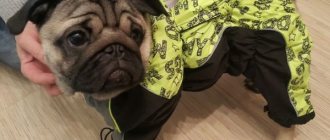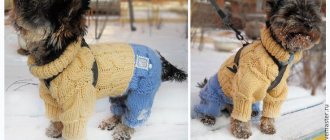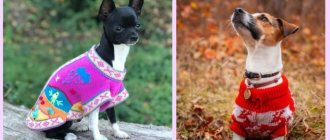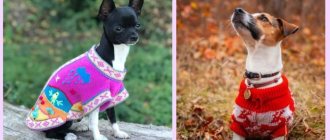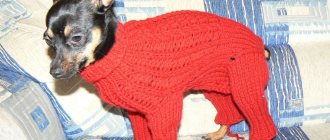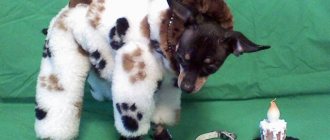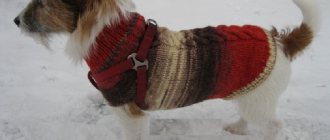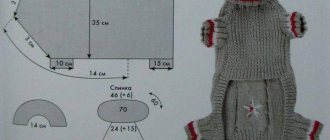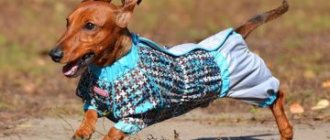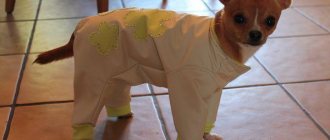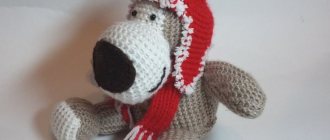Variety of warm clothes
Clothes for dogs can be casual or formal. There are many types of clothing:
- overalls;
- blanket;
- sweater or jumper;
- dress;
- panties.
A knitted suit will give your pet a unique appearance.
For your information! The easiest product to make is a cape. To knit it you do not need to have perfect technique. These clothes are suitable for cool spring or autumn. In winter, more thorough insulation is still required in the form of overalls or a set of pants and a jacket for a dog.
In addition to basic clothing, hats of various styles and dog shoes are popular among animals.
Yorkie feels cozy and warm in a knitted hat
When choosing a model, you should pay attention not only to beauty, but also to practicality:
- the ties must be of sufficient length so that they do not come undone during walks;
- clothing should not hinder the pet’s movements;
- the collar should fit freely under or on top of the product;
- The length of the sleeves and panties should be shortened, otherwise the lower edges will quickly wear out.
Let's start with the hook
There are many techniques for crocheting. Let's look at two of them:
- Moroccan technology;
The use of this technique provides such advantages as the tightness of the knitted clothing and retention of shape for a long time. Typically, sleeveless vests, blankets and capes are knitted using this technique, which turn out very beautiful.
- Freeform knitting technique.
In this technique, first, a full-size pattern is drawn up and only then the elements of the future clothing are knitted. As a result, all elements are connected to each other using a thread or hook. The freeform knitting technique will take a little more time, but it will be worth it. Clothes made using this technique are absolutely original and unique.
Related article: Cocoon coat with one-piece sleeves: free sewing pattern
But what to do with the fact that crocheted dog clothes are not warm? This problem can also be solved, and there are several options for getting out of this situation:
- You can use a lining that is sewn from the inside out. It is important to note that this option will significantly complicate the washing process. However, if your pet also has other clothes, this will not be a problem;
- The second option is to decorate products with ornaments that can be embroidered on the finished item or knitted - this will help retain heat.
Principles of knitting dog clothes
Knitting overalls for a mini Yorkie boy
Recommendations for knitting clothes for dogs exist specifically for each product. But there are basic rules that will answer the question of how to knit clothes for any dog:
- Before you get to work, you need to decide on the knitting density. To do this, knit a sample of the pattern and count the number of loops contained in 1 cm. The number will differ depending on the chosen yarn;
- after taking measurements of the dog, you need to decide on the size and determine the appropriate number of loops according to the width of the product;
- Be sure to try on the product while knitting, this will allow you to immediately adjust the size of the fabric.
Note! To knit dog clothes you will need very little yarn. You can use leftovers from other items or dismantle an old unnecessary item.
Model selection
Before crocheting or knitting clothes for a dog, you need to decide on the model. It all depends on the pet’s physique, skills, and individual preferences. There are the following types of warm clothes knitted for dogs using do-it-yourself patterns:
- sweater;
- overalls;
- vest;
- coat.
The simplest option is knitting a vest. Other models require more serious skills. But it should be borne in mind that this item is more suitable for autumn, since it does not have sleeves. For winter frosts you need to knit a sweater or coat.
Taking measurements for knitting
Sweater for a dog: how to knit for beginners
This is the most responsible process. The appearance of the finished clothing and how it will fit on the dog depend on correctly measured volumes and lengths. If the dog is very active, it is problematic to cope alone, it is better to turn to someone for help.
Basic measurements you will need when knitting dog clothes:
- chest girth. Measured at the widest part of the chest;
- neck girth. On the contrary, they measure in the narrowest place;
- back length. Measure from the beginning of the neck to the tip of the tail;
- paw length Measure from the armpit to the ground. The parameter is useful for products with sleeves or panties;
- paw girth The parameter is measured at the widest part of the limbs;
- distance between paws. This size is important when knitting overalls.
To take measurements correctly, you need to use the table
How to choose the right clothes for your pet?
If the dog owner decides to purchase a factory-made outfit for his four-legged friend, he should know about the intricacies of choosing dog clothing. First of all, you need to think about the comfort of the animal, and only then about beauty.
If it is not possible to try on clothes for a Yorkie, especially when purchasing online, then it is enough to know the dog’s parameters, including the following criteria:
- girth of the widest part of the Yorkie's neck;
- distance from withers to tail;
- the volume of the dog’s chest and waist (plus 5 free centimeters);
- length of paw to big toe.
When choosing clothes in a store where you can touch and inspect them, as well as try them on, you should heed the advice. What you should pay attention to when buying an outfit for a small dog:
- Determination of fabric quality. You need to wrinkle the material and see if the design cracks. Low-quality dyes, when exposed to moisture and sun, stain the animal’s fur.
- Location of seams. The internal stitching should not stick out too much, rub or hurt the dog.
- Unnecessary decorations. It is better to exclude additional pockets, belts, and a hood that do not provide functionality from the Yorkie’s wardrobe; such accessories interfere with the dog’s walking.
- Choice of clasp. If the dog has long hair, it is better to choose clothes with buttons or Velcro, for example, Yorkie hairs often get caught in the zipper. For trimmed dogs, any type of fastener is suitable.
What to knit clothes for your pet from
DIY dog clothes: patterns
When choosing yarn, you need to take into account the properties of the material, the particular conditions of washing and drying the finished product. The main synthetic fibers are:
- acrylic (PAN). If the yarn is of high quality, the items made from it are light, retain heat well, and practically do not shrink after washing;
- viscose. If the threads consist entirely of viscose, during wear such items do not hold their shape well and are stretched.
Note! Natural threads are hypoallergenic, but more difficult to care for. Products made from such yarn should be washed at low temperatures and dried without the use of heating devices.
The following types are distinguished:
- linen. Durable yarn. Things made from it are durable and of high quality, and are little susceptible to shrinkage after washing;
- cotton. Pleasant to the touch, quite durable, but not elastic. Cotton yarn is heavy;
- wool. The warmest yarn. But woolen items do not last long, they form pills and shrink heavily after washing.
Selection of materials and tools for work
The main materials that any needlewoman uses for knitting:
- Circular and stocking needles.
- Crochet hooks.
- Markers for knitting.
- Tape for measurements;
- Scissors.
For small breed dogs, it is better to choose thin yarn so that the knitted fabric does not bunch up on the bend lines, creating discomfort for the pet. This means that knitting needles and hooks must also be thin.
A DIY jumpsuit or sweater for a dog will envelop your pet in warmth and love. And knitting products is not as difficult as it might seem at first glance.
How to knit a jumpsuit for a small dog with knitting needles
A warm overall is a full-fledged dog suit that protects the front and back parts of the body. Perfect for miniature breeds that freeze in cold weather.
Knitting a jumpsuit for a small dog is not difficult
The procedure for knitting overalls for a small dog:
- For the hind legs, you need to cast on 30 chain stitches from different balls, then knit 5 rows with a 2x2 elastic band. Then knit 12 rows in stockinette stitch and 3 rows in rib stitch. Close 4 loops (p.) on the inside, and 10 stitches on the outside. A total of 16 sts should remain.
- Cast on 14 stitches and connect the legs together. A total of 46 stitches are obtained (2×16 + 14). Next, knit 6 rows with an elastic band, 18 rows with stockinette stitch. Then cast on 14 loops from each edge. A total of 74 stitches are obtained (46 + 2×14). Next 6 rows are knitted according to the pattern: 18 sts - rib stitch, 38 sts - stockinette stitch, 18 sts - rib stitch. Next, knit 12 rows in stockinette stitch.
- For the front legs, knitting begins in the same way as the hind legs. You need to cast on 30 air loops from different balls, then knit 5 rows with a 2x2 elastic band. Then knit 14 rows in stockinette stitch.
- To knit raglan, the parts are connected to each other. To do this, knit 15 stitches together with the edge (chest), 30 stitches (sleeve), 44 stitches (back), 30 stitches (second sleeve), 15 stitches (breast). The total is 134 sts. This is how 2 rows are knitted. From the third row they begin to reduce the number of loops. To do this, in every second row, decrease 1 stitch, not reaching 2 edge stitches.
- When 70 stitches remain on the knitting needles, knit 4 more rows, decreasing only at the beginning. A total of 58 stitches remain. Then knit 4 rows with an elastic band and close 4 stitches from each edge.
- When 50 stitches remain on the knitting needles, start working on the hood. Knit in stockinette stitch. In the middle, make an expansion 4 times: add 1 stitch to the 2 middle sts in every fourth row. A total of 58 stitches are obtained. Knit 10 rows without additions. Then they begin to decrease 2 loops in the middle in every second row. This is done 7 times. A total of 44 stitches remain. Knit 5 rows with an elastic band and bind off all the loops. The sleeves are sewn together and the zipper is attached.
Stage 2. Raglan
In order to knit a raglan correctly, you need to take into account the anatomical features of the pet.
The pug has a wide back and chest, a short body. Therefore, the raglan will look like this:
100 loops / 8 = 12.5
Back - 4 parts: 4*12.5=50
Chest - 2 parts: 2*12.5=25
Hands in 1 part: 1*12.5=12.5 - not a whole number, 0.5+0.5=1 loop, send to the chest.
But 12 stitches for a sleeve is too much. Therefore, we transfer 2 points each to the chest and back.
52+10+28+10
Of the 10 sleeve loops, 3 loops are raglan lines. We knit raglan to the required length - 20 cm.
Step-by-step description of knitting a sweater for a pet
It is not necessary that the hand be full. To knit a simple sweater for a Chihuahua, some basic skills are enough. A pattern and knitting pattern for a simple sweater for a dog won’t even be useful. An elementary lesson will help you figure out how to knit a sweater for your pet.
Materials you will need:
- warm melange yarn;
- knitting needles No. 4;
- bobbin threads;
- scissors;
- needle.
For your information! Knitting begins with a collar with 1×1 or 2×2 rib. It should not be knitted too tightly so that it is easy to put on and take off. The average collar width for small dog breeds is 5 cm. After the end of the collar, the main part begins.
The main fabric is knitted in stockinette stitch. Starting from the third row, add 2 loops in each subsequent row. You need to add until the width of the product is equal to the circumference of the dog’s chest + 2 cm for allowances. At this stage, it is recommended to first try the sweater on your pet to make sure it is the right size. Next, knit 3 more rows without additions.
Knitting holes for paws
To make holes for the paws, you need to skip the required number of loops corresponding to the size. To do this, knit the first 3 cm, cover the next 6 cm, then knit to the second armhole. When a sleeve of the appropriate size is obtained, air loops are added and then knitted with a single piece of fabric. The edges are tied. You can use a hook for this.
Then, to narrow the product towards the bottom, you need to decrease 2 loops in every seventh row.
Important! As you knit, you need to regularly try on the product for the future owner.
When the length of the fabric is sufficient, you need to finish the product by knitting the edge with a 1x1 or 2x2 elastic band. To assemble the sweater, the edges are sewn together with threads.
A dog in a knitted sweater feels comfortable
Manufacturing instructions
More precise instructions for knitting clothes depend on the model chosen. Even novice craftsmen can create knitted clothes for Chihuahuas using patterns using their own hands. There are several general rules that must be followed when knitting clothes for a dachshund with your own hands according to patterns:
- Depending on the type of yarn chosen, it is necessary to count the number of loops that will be distributed in 1 cm. Next, you need to calculate the number of loops depending on the measurements taken. Of course, their number will be small if you plan to knit a vest or blanket for a small dog. To do this, you need to knit a small piece of the pattern.
- Each part of the product must be knitted separately, and then connected to each other using a needle and bobbin threads. But when creating a vest, you can knit the item in the round.
- The blanket can be knitted with a continuous fabric without interrupting the process.
- When the knitted clothes for dogs according to the patterns are almost ready, you can try on the product, and then add the collar and elastic at the bottom.
If the master is not confident in his skills and does not want to waste new yarn, then you can knit clothes for a Chihuahua using knitting needles according to the pattern from any unnecessary thing. There are interesting options for converting old house clothes into costumes for pets.
For example, you can easily make a similar thing for a dog from a children's sweater. To do this, you just need to sew it in a little depending on the size of the animal, and also insert elastic bands at the neck, waist and sleeves.
If you didn’t manage to knit a masterpiece the first time, don’t be upset, because you can easily unravel the failed item and try to knit it again. But when a good thing comes out, the animal will look extraordinary and attractive, and the main thing is that it will be warm in rainy, dank and frosty weather.
Dress for a small dog: knitting options
Yorkshire terriers and other small dogs look adorable in tiny dresses. The dress can be knitted in regular stockinette stitch and additionally decorated with crocheted flowers, bows or frills.
The dress itself can be of the following types:
- classic. With sleeves and skirt. You can add buttons or knit openwork patterns. Usually the dress is knitted according to a pre-made pattern;
- with ruffles. Ruffles will add volume and elegance. They can be knitted on the sleeves, skirt or collar;
- tunic dress. A shortened model without a pronounced transition to the skirt. It is recommended to knit from insulated yarn with the addition of mohair;
- sundress. Sleeveless strappy dress. Knit from cotton or acrylic yarn in an openwork pattern. Great for summer walks and going out.
Yarn and accessories
Once the model has been determined, everything necessary for work should be prepared. So, the following accessories will be useful in the process:
- Yarn (both acrylic and wool containing are suitable).
- Knitting needles or crochet hook (depending on preferences and skills).
- Reel threads.
- Needle.
- Scissors.
- Thimble.
- Tape measure.
- A pen and a small sheet of paper (for notes while taking measurements from the animal).
In some models, accessories may be useful: hooks, buttons, buttons or a zipper. It is recommended to prepare all this in advance. Bobbin threads must be selected to match the selected yarn. It is not recommended to skimp on the materials needed to make clothes.
Patterns may vary depending on measurements.
Knitting kit for a dog: jumper and helmet
When walking in windy weather, special attention should be paid to protecting your pet's ears and head. A hat and hood will help you cope with this task. The helmet hat does not fall off the head and does not creep over the eyes; it covers not only the top of the head, but also the neck. The hood provides additional insulation. To knit a jumper and a hat-helmet for a small dog, you will need:
- 200 g yarn;
- straight and double needles No. 2.5.
Important! Knitting is done from top to bottom.
Cast on 46 stitches on straight knitting needles and knit 2 rows in garter stitch. Then knit 20 rows with a 1×1 rib. Then they move to the front surface. In the first row, 3 loops retreat from the edge, in the second - 4 loops, in the third - 5 and so on, add 1 loop on both sides in each row 15 times. The total is 28 rows from the elastic band.
For armholes, 10 stitches in stockinette stitch (for the chest), 12 stitches are cast off (for the armhole), 32 loops in stitch stitch (for the back), 12 loops are cast off (for the second armhole), 10 loops in stitch stitch (for the chest) and knit a row separately on every part. Then knit through all the loops, restoring 12 loops of each armhole. In total, you should get 72 rows from the elastic band. At the end, knit 4 rows with an elastic band and close all the loops.
For the sleeves, cast on 28 stitches along the edge of the armholes on stocking needles and knit 18 rows in the round with a 1×1 elastic band, cast off all stitches.
To connect, the middle seam of the jumper is made, the collar is left unsewn.
For the helmet, cast on 86 stitches on straight needles and knit 12 rows in stockinette stitch. For ties, you need to close 14 loops at both ends in the 4th row from the beginning of knitting.
After completing the 12th row, you need to divide the fabric into 3 parts: 2 × 15 loops for the side parts and 28 loops for the top part. Next, knit 4 rows, decreasing 1 loop in every second row 14 times on both sides of the upper part of the fabric. Close all loops. A seam is made in the middle of the cap. Having laid a small fold, the hood is hemmed to the hat.
We knit clothes for dogs with our own hands in step-by-step lessons
Symbols in diagrams:
- air loop - air loop
- st/s/n – double crochet
- st/b/n – single crochet
- connect/st – connecting column (half single crochet)
- n. - loop
This sweater is very easy to knit with your own hands, it is easy to put on and fastens with a button at the neck of the belly strap. To work you will need:
- Basic yarn: about 200-250 g for a small dog.
- A small amount of yarn in a contrasting shade for edging.
- Hook number 6 or 6.5.
- Large button approximately 2.5 cm in diameter.
If the dog is large, you can change the size of the sweater by adding rows (1 row of sc/b/n is approximately equal to 8mm). You can also reduce the size. Be sure to try on the sweater as you go!
We knit a sweater collar.
We cast on 23 in/p, knit the 1st row with st/b/n from the 2nd loop from the hook. At the end of the row, VP and move to the 2nd row. Up to the 50th row inclusive we continue to knit st/b/n. Then st/b/n behind the back wall, in/p, at the end the thread is not secured.
Leaving the hook in the last loop, we combine the first and last rows with half-columns. In this way we connect all the rows, closing the collar. At the end of 2nd stitch, do not fasten the thread.
We knit the main part of the sweater.
Along the rim of the collar we knit 48 sts/s/n, leaving the remaining columns of the collar free. We knit 2 single rises and move to the next row. Up to the 22nd row we continue to knit the same st/s/n. Here, if necessary, you can add rows, increasing the size. In the next row we make a decrease to the required amount, knitting st/s/n through one loop. We knit a few more rows and secure the thread.
We knit a sweater strap.
We knit from the end of the 15th row from the collar along the edge of the product 13 st/s/n. We start each next row with 2 high rises. Starting from the 21st row, we make a hole for the button, skipping st/s/n and knitting in/c. It's better to make 2 holes. In the last row we knit st/s/n without gaps.
We knit a finishing row along the edge of the product, including the untied part of the collar.
At the level of the 15th row from the collar, sew on a button.
Knitting raglan for dogs: pattern with description
When knitting raglan, the sleeve is not separated from the shoulder part of the front and back. First, the neck of the product is knitted with an elastic band. To get a raglan, you need to divide the number of loops into 3 parts: for the back, front and legs. The number of paw loops is divided in half. For convenience, it is recommended to use knitting markers; they will delimit the details.
Then you need to make an extension of the product using yarn overs. 2 loops before the first marker, a yarn over is made, 2 purl loops are knitted, a marker is thrown over, 2 more purl loops and a yarn over. These steps are repeated with each marker. Due to the yarn overs, the fabric will expand.
Raglan knitting pattern for dogs
To calculate the width of the sleeves, you need to calculate the number of loops based on the circumference of the paws. These loops are moved to the second knitting needle; they will be needed after completing the knitting of the main part. To keep the sleeve free, you need to knit 5-10 additional loops. Next, knit in the round with a 2×2 elastic band to the required length.
Stage 5. Extended back
In order to knit the back, take an additional needle and transfer all the “front” loops to it (28+4 increases).
We will knit rotary short rows - 5 r.
How to knit short rows?
1 rub. - knit stitches from the beginning to the end of the row (except 32 p.)
2 r. - turn the knitting, knit the purl loops, not knitting 5 loops to the end of the row, turn the knitting. At the same time, we remove the last loop before them without knitting.
Repeat 10 times or 5 rows, at the beginning and at the end of the row.
After this we knit two smoothing rows, knitting all the loops.
We switch to the elastic band pattern “1×1” - 4 cm.
How to knit a blanket and beret for a dog
A blanket is the simplest clothing option. It can be made without a pattern. Even a beginner can handle it. It can be knitted in satin stitch or with openwork patterns.
The easiest variety to execute is the triangular blanket. It is suitable for small dogs. Knitting starts from the tail. At this point a loop is made that is put on the dog's tail. Next, add loops evenly. The length of the blanket should slightly exceed the length of the animal's back. Fasteners (buttons, Velcro) or ribbons are sewn to the remaining corners to secure the cape on the stomach.
For your information! The blanket can be rectangular in shape. To prevent the edges of the cape from bending, several loops on both edges are made into scarf loops.
To make a beret, knit a chain of 4 chain stitches and close it in a circle. Then knit 12 rows with a single crochet, adding 8 loops in each row. Next, knit 4 rows with a decrease in the number of loops. Then all the loops are closed and the edge is tied in a “crawfish step”. You can sew a pompom to the center of the beret.
The blanket will be an excellent option for walking in cool weather.
If you plan to make a striped beret from yarn of several colors, it is recommended to knit 3 rows of each color.
Knitted shoes for small dogs
Knitted shoes are light and comfortable. It does not rub or hinder your pet's movements. At the same time, it does an excellent job of keeping the dog’s paws warm. With shoes on, your pet can stand on cold ground for a long time and remain healthy.
To ensure your boots last a long time, it is recommended:
- insert insoles made of thick fabric into the shoes;
- the sole is made of waterproof thick material;
- knit the rest of the shoes in a circle with yarn in the direction from the sole upwards;
- Strengthen your socks with a leather or nylon insert to prevent your dog from tearing your shoes with his claws.
Note! Strong threads are used to knit shoes. Any knitting style is suitable.
Miniature dog breeds need extra care, especially during cold season. The above detailed information will help you learn knitting for dogs without any problems. Tips on choosing styles and selecting yarn will guide you among the many options.
What patterns can be used
The choice of pattern depends on how warm the product should be. In winter, when it is necessary to warm the pet, a tight knit is chosen. Openwork models made of cotton threads are good for summer.
The report (width/height) of the diagram should be small, since the jacket will end up being small. Magazines for knitting children's items will help you choose a pattern with a detailed description.
Openwork
Small dogs can wear openwork sweaters even on cool summer evenings. In such patterns, facial loops and yarn overs are used. Thanks to the yarn overs, which are arranged in a special way, a lace pattern is obtained, making the product weightless.
Jacquard
The jacquard pattern is knitted with knit stitches, combining multi-colored threads. This can be a small pattern of five different colored threads or a knitted pattern located on the back of the overalls.
When choosing yarn to create this pattern, not only color combinations are taken into account, but also the thickness of the threads - it must match. Otherwise, the product will not be uniform in thickness.
Embossed
Relief patterns combine front and back loops, with the help of which the relief is created. This type of knitting requires careful attention from the craftsman, as mistakes will lead to the disappearance of the relief.
The owner of the dog can dress up his pet to his liking, and he can create clothes for him with his own hands, for example, knit. Even if the first jumpsuit turns out completely different from the one in the picture, it doesn’t matter - you can always add an original decoration to make the product original, author’s, “designer”.
Take into account your own mistakes, make adjustments to the patterns, then each subsequent work will be much better than the previous one. Patterns for hand-knitted clothes for dogs can be found on specialized resources or you can create them yourself, focusing on the sizes.
